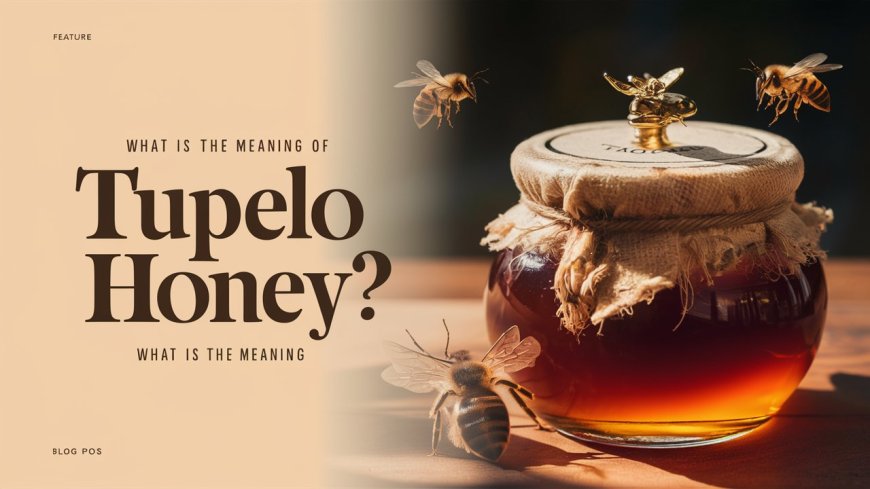What Is The Meaning Of Tupelo Honey?
Discover the unique taste and history of Tupelo honey. Learn why this rare honey is so prized and what makes it special.

Have you ever tasted something so uniquely delicious that it lingered in your memory long after the last drop? That's the magic of Tupelo honey. Often hailed as the "fine wine of honey," this rare and coveted nectar has a story as rich and complex as its flavor.
Tupelo honey - which you can get for yourself from Smiley Honey - comes from a specific tree. The white tupelo (Nyssa ogeche) - grows in the southeastern United States, primarily in Florida and Georgia.
What Is Tupelo Honey, Anyway?
Would you believe us if we told you this special honey is from a misty swamp in the southeastern United States? The white tupelo tree, also known as Nyssa ogeche, Ogeechee lime, or white gum tupelo isn't just any tree.
For a brief window each year, usually in April and May, these trees burst into bloom. Their delicate flowers become the favorite attraction for honeybees, who work tirelessly to collect the precious nectar. The result? Pure, unadulterated Tupelo honey.
But this honey isn't only rare because of its short harvest window. The trees themselves are picky about where they grow. You'll only find them in specific areas, primarily:
-
The Apalachicola River basin in Florida
-
The Okeefenokee Wildlife Refuge along the Georgia-Florida border
These swampy, flood-prone areas are the perfect home for white tupelo trees. But they're not exactly easy places for beekeepers to work!
Read More Article: The Impact of ABA Therapy on Children with Autism in Houston, Texas
The Beekeepers' Challenge: Harvesting The Honey
Imagine being a beekeeper trying to harvest Tupelo honey. It's not your average day at the office! These dedicated folks have to:
-
Place hives on platforms or floats in swampy areas
-
Carefully time the harvest to coincide with the brief tupelo bloom
-
Ensure the bees focus primarily on tupelo nectar for pure honey
It's a labor of love, requiring skill, patience, and a deep understanding of both the bees and the local ecosystem. No wonder Tupelo honey for sale commands a premium price!
The Taste That Launched a Thousand Ships (or at least a Famous Song)
Now, let's talk flavor. Here's what makes it stand out:
-
A unique floral and buttery flavor profile
-
Hints of cinnamon and a slight spice
-
A light amber color with a distinctive greenish hue
But the magic doesn't stop there. This honey has a secret superpower - it resists crystallization. Thanks to its high fructose-to-glucose ratio, this honey stays liquid longer than many other varieties. No more rock-hard honey jars in your pantry!
This exceptional taste hasn't gone unnoticed. Tupelo Honey even inspired Van Morrison's 1971 hit song "Tupelo Honey."
Health Benefits: More Than Just a Pretty Taste
It is a treat for your taste buds all the while giving you some serious health benefits too.
-
High in antioxidants: Tupelo honey boasts a high Oxygen Radical Absorbance Capacity (ORAC) value. In plain English? It's great at fighting those pesky free radicals that can damage your cells.
-
Anti-inflammatory properties: Like other honey, Tupelo honey may help reduce inflammation in the body.
-
Antimicrobial powerhouse: Historically, honey has been used for its ability to fight off harmful bacteria. Tupelo honey is no exception.
-
Wound healing potential: Some folks swear by honey for helping cuts and scrapes heal faster.
A Cultural Icon: Tupelo Honey's Place in Southern Heritage
Tupelo honey is a cultural touchstone in the regions where it's produced. Every year, beekeepers and honey enthusiasts gather at the Tupelo Honey Festival in Wewahitchka, Florida. It's a celebration of this unique honey and the hardworking folks who bring it to our tables.
But the honey's fame extends beyond local festivals. In 1997, the film "Ulee's Gold" shone a spotlight on Tupelo honey production, introducing this liquid gold to an even wider audience.
Tupelo Honey For Sale: What to Look For
Excited to try this honey for yourself? Here's what to keep in mind when you're shopping:
-
Look for certifications: Some producers have their honey certified by independent labs to guarantee purity.
-
Check the source: Authentic Tupelo honey should come from the southeastern United States, specifically Florida or Georgia.
-
Color matters: Remember that distinctive light amber color with a greenish tint? That's what you're looking for.
-
Price point: Pure honey is rare and labor-intensive to produce. If you find a jar that seems too cheap to be true, it probably is.
-
Read the label: Look for 100% pure Tupelo honey. Some products might be blends, which won't give you the full Tupelo experience.
Read More Article: Understanding ABA Therapy: What Families in Colorado Springs Need to Know
The Future of Tupelo Honey: Are There Any Challenges?
As delicious as Tupelo honey is, its future isn't all sweetness and light. The delicate ecosystem that produces this honey faces several challenges:
-
Climate change: Shifting weather patterns could affect the tupelo trees' blooming cycle.
-
Habitat loss: Development in swampy areas threatens the trees' natural habitat.
-
Bee health: Like all honey producers, Tupelo honey relies on healthy bee populations.
But it's not all doom and gloom. Many beekeepers and conservationists are working hard to protect the tupelo trees and their swampy homes.
Get Your Own Tupelo Honey
Whether you're a hardcore foodie, a health enthusiast, or just someone who appreciates the finer things in life, Tupelo Honey has something to offer. Its unique flavor, potential health benefits, and fascinating story make it more than worthy of a place in your pantry.
So the next time you're looking to add a touch of sweetness to your life, why not reach for a jar of Tupelo honey? Or if you don’t have it, just order it from Smiley Honey.
What's Your Reaction?




































